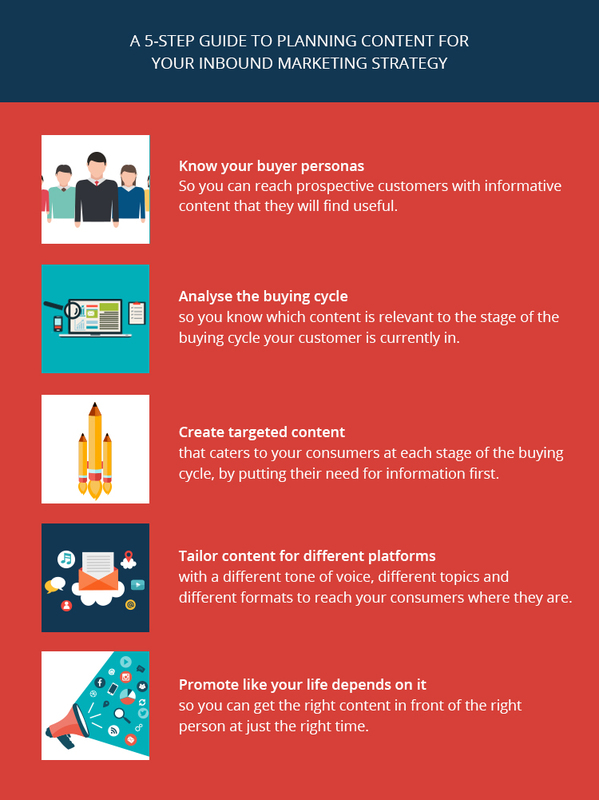Content forms the backbone of your inbound marketing strategy. As we stated in our earlier blog post, Inbound Marketing: The next big thing for your brand,
Social media, emails, SEO, blogs, video – every platform or channel you use in your strategy will require you to create extraordinary content that’s compelling enough to draw your target audiences in.
When you’re competing for attention rather than space, the idea is to churn out quality content that adds value to your consumer, thus pulling attention to your brand.
A well-planned inbound marketing strategy backed by quality content will help your brand grow and be found by potential customers in the digital space. Check out these five essential steps for planning content for inbound marketing:
Step 1: Know your buyer personas
Know who your ideal customers are, what they do for a living, what their aspirations and challenges are and map out their personalities and pain points. Take a look at people already buying from you, learn about their challenges, goals and get feedback about your product, then spot the patterns and trends in their answers. And then, in turn, reach them with informative content that they will find useful.
Creating sample buyer profiles to represent your different buyers is also a good idea – it may take a while, but the next time you’re generating content, you’ll know exactly whom you’re writing for and the more effective and result-driven your content will be.
Step 2: Analyse the buying cycle
Your content will be most informative for your consumer when it’s relevant to the stage of the buying cycle he/she is currently in.
- Awareness – where your prospective consumer will conduct research on his problem or his need.
- Consideration – where he searches for ways to solve his problem or fulfill his need.
- Buying decision – where he evaluates vendors and products, shortlists them and eventually reaches a buying decision.
Aim to educate your consumer at each stage of the buying cycle – your content is the perfect tool to pull them from one stage to another. By putting out content that is informative, relevant and exceptional, you can draw people onto your site, convert them into leads and then close them into customers.

Step 3: Create targeted content
Your content is going to be vying for attention on the Internet, so make sure it has a purpose and is valuable enough to grab your prospective customers’ attention.
Exceptional content caters to your consumers at each stage of the buying cycle, by putting their need for information first:
The awareness stage – Skip the promotional content altogether in favor of content that helps educate your prospect.
The consideration stage – Generate content about solutions to your prospects’ problems, without centering it around your brand.
The buying decision phase – Create content that shows your prospects the value that your brand will add to their life, as a solution to their problem.
Step 4: Tailor content for different platforms
Just as your content will differ for different buyers in various stages of their buying cycle, it will change according to the platform you’ll be using to publish it. Each piece of content should have a clear goal and be measurable.
Emailers may be sent out to generate leads, educate your existing & prospective client base, nurture existing leads and more. The right email needs to reach the right person at the right time, adding value to customers and prospects instead of being directly promotional.
In a similar manner, social media is all about sharing content in a customized, personal way that your audiences will relate to rather than being promotional. Your content should be different for different platforms – more visual and personal for Facebook, concise and conversational for Twitter, professional for LinkedIn and so on.
When you’re writing blogs posts, on the other hand, your content, approach, and tone will change with each post. A blog will help you attract visitors to your site and convert them to leads or establish yourself as a thought leader in your industry – your content and tone will vary accordingly.
Step 5: Promote like your life depends on it
Knowing how to use your content and pushing it is what makes it relevant for your audience. You can’t assume that your prospective customers will find your content – you need to distribute it and promote it via your website, landing page, blog, social media and even emailers. Track where your personas are spending time and reach them with the right content for those platforms.
Without promotion, your content won’t make an impact or draw your consumers in – the right platform will get the right content in front of the right person at just the right time.
Content that adds value will not only grab your prospects’ attention but also help you nurture and close them into customers. The rule behind inbound marketing is that customers don’t want to be sold to anymore – if you want to grow your business in the digital space, content that engages and educates your customers will take your brand forward over the long haul.












Leave a comment
Comments (0)
Be the first one to comment.